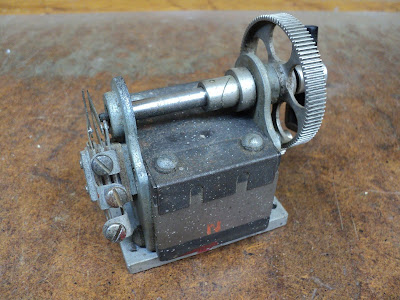It's a four-position rotary switch with wire-wound resistors built into the rear of it.
Stamped on the metal shell is "ARK-LES"
[1]. The Ark-Les brand is still with us, though their
website is a disaster right now. Every link just brings up a bit of gibberish.
- - -
I suspect that this switch must have been meant to be the heater-blower speed control switch for the cabin of a car or truck.
I'm a bit baffled by the knob. The knob surely has to be removable in order for the switch's shank to be installed in a panel, but the knob is stuck fast. I'll try warming it with a heat gun and see if it pulls straight off.
- - -
Hmmm. That didn't work. There's no pulling the knob straight off, and it doesn't want to unscrew in either direction. This makes no sense. The knob has to come off in order for the switch to be installable.
So ok; let's try this. I'll clamp the knob in my mechanic's vise in such a way that I can pry up on the metal shell with the knob held in place.
Here goes.
- - -
And that worked. I managed to get the knob free.
Now the question arises, should I go further and separate the metal shell from the ceramic base? That risks fatiguing and breaking the fastening tabs, but what the hey, let's have a look inside.
- - -
And here we are with the components separated and lined up.
- - -
Uh-Oh
This switch has a defect. The centre resistors-connection crimp terminal at the rear is flaky. Someone has attempted to solder it in the past.
The solder didn't take to the resistance wire. I tried solder again after thoroughly scraping clean the area, but it was no go. Solder simply will not take to the resistance wire.
So, I centre-punched the connection all around to try and establish a renewed crimp effect.
That may work, though I'm not confident that it's a truly sound repair. I'll reassemble the switch and try it out with a small DC motor. If nothing else, I'll keep the switch as a curiosity.
- - -
It works. Here's an annotated schematic of the thing.
* * *
Note:
[1] A little play on words there, I imagine; ARC-LES = arcless. My schematic doesn't show it, but the switch is a make-before-break type, which I suppose would inhibit arcing as switch position is changed.
# # #
# # #
























